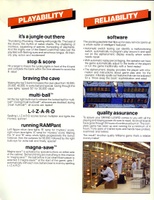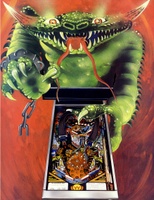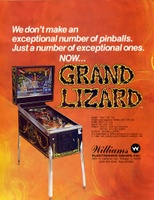

Grand Lizard
Originally, the backglass was to have the standard numeric-only display windows. When the game went into production, the backglass was redesigned to incorporate new alphanumeric displays, and its artwork was changed. Initial backglass and playfield artwork by Paul Faris. Final production backglass artwork by Python Anghelo. Compare the playfield to the two-level playfield of Williams' 1981 'Solar Fire'. Pictured in this listing is an NOS playfield still in its shipping cabinet from the manufacturer. 'Grand Lizard' is one of three Williams games that went into production using System 11. All three games have incorrect schematics showing the same error by depicting placement of the flipper end-of-stroke switch on the wrong side of the coil. As far as we know, all games left the factory correctly wired for EOS. Only the schematics were incorrect. No Manual Amendments or Service Bulletins have been found that acknowledge or correct this error. For a correct drawing of EOSS placement, consult the schematic for Williams' 1986 'PIN�BOT' or subsequent Williams games. Programmer Ed Suchocki shares this information about Grand Lizard:Bill Parod was the sound designer on this game. The background drum music was the first time that Williams games used digitized audio samples for music. After Bill worked on Grand Lizard, he improved his technique of digitized music samples on the High Speed pinball game.


















































